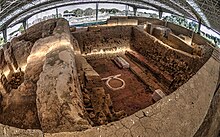Shen ring
In ancient Egypt a shen ring was a circle with a line tangent to it, represented in hieroglyphs as a stylised loop of a rope. The word shen itself means, in ancient Egyptian, encircle, while the shen ring represented eternal protection.
The shen ring is most often seen carried by the falcon god Horus, but was also carried by the vulture goddess Nekhbet. It was used as early as the Third Dynasty where it can be seen in the reliefs from Djoser's Step Pyramid complex.[1]
| |||||
| Shen ring – (in talons) Cartouche in hieroglyphs |
|---|
The symbol could be stretched to contain other objects, which were then understood as being eternally protected by the shen ring.[citation needed] In its elongated form the shen ring became the cartouche, which enclosed and protected a royal name.[2]
- The Goddess Heqet, (the 'Frog'), is often seated on a shenu.
- For Eternity, the renpit, papyrus stalk is usually based on top of a Shen ring. See the Egyptian god Huh. (Senusret I has a famous Lintel relief showing this.)
- The Shen ring is often attached to various types of staffs, the staff of authority, or power, symbolizing the Eternal authority of that power.
- The Goddess Isis, and the Goddess Nekhbet are often shown kneeling, with their hands resting upon a shenu.
- The Hawk (Horus), and the Vulture (Goddess Mut) have the shenu in their talons, wings outstretched, over the scene portrayed. The "Horus with Outstretched Wings", shenus in its talons, is an example from the Louvre of a Pectoral Brooch, possibly for royalty.
Outside of Egypt, a Tartessian archaeological site in southern Spain has a shen shaped altar.

See also[edit]
References[edit]
- Kemp, Barry (2007). Ancient Egypt. Anatomy of a Civilisation. Routledge, Oxford.
| Wikimedia Commons has media related to Category:Shen ring. |
| Wikimedia Commons has media related to Category:Shen ring steles. |

